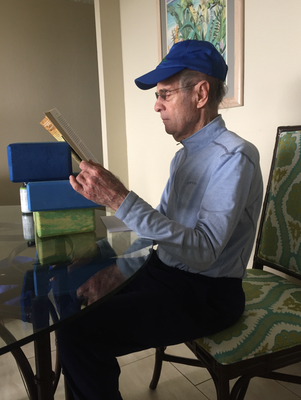
I am fascinated by how everyday habits of movement affect overall health. Sitting is one the top of the list. By now, most people have heard about how too much sitting is deleterious to our health. While it’s true that continuous sitting causes a whole array of problems, sitting in and of itself is a natural human movement.
The main problem with sitting while reading is that it often leads to prolonged slouching. Eye placement is a major culprit. Vision is a powerful force. The entire shape of our body gets determined by where we place our eyes. For example, looking down with our eyes inhibits the extensor muscles in our upper spine. This means that when we look down we don’t have as much muscular support to sit up nice and tall. When sitting at a table or desk, most people naturally place the book on the flat surface and look down. Over time, this downward gaze encourages a forward rounding of the spine.
Most people will now agree that a lot of sitting is bad for the body and that reading is good for the mind. So what can we do? People usually sit while they read and it’s a hard habit to change.
When I hear things like the above sentence, my mind always thinks of the rare exceptions. In this instance, I think of a few people I know who enjoy reading while walking. For example, when I was a kid living in Minnesota, there was a man well-known for simultaneously reading and walking around Lake Bde Maka Ska. This fellow would nonchalantly hold a book in one hand as he sauntered along the 3.4 mile asphalt path. While it seemed easy for him, I don’t recommend it. Our proprioceptive system (how body understands how to move in space) does not expect our bodies to be moving forward when our eyes are facing down. This sensory mismatch confuses the brain. On a more mundane level, there are a lot of trees around the lake and the ice can be very slippery in winter.
While reading at a standing desk or lying down are excellent alternatives to walking while reading, they too are not always realistic. The space might not be appropriate or the reader may simply find it too awkward, beyond their comfort zone, or beyond their current physical ability. If one has read in a seated position at a table for decades, it’s not easy to make a drastic change. Fortunately, there are other small changes that one can make to ensure that reading while sitting doesn’t turn into a slouch fest.
So what can one do to make a realistic and sustainable change?
First, pay attention to how you sit in the chair. Instead of leaning backwards, try sitting on the chair in such a way that you sit on the front edge of your sit bones, the two pointy bottom parts of your pelvis. By sitting like this, you will be positioning your pelvis in a way that supports length in the spine. For a visual, look at the video How to Sit In a Chair – put link here
The next step is to position the book closer to your eyes so you don’t have to flex your neck to see the words. Do this by adding some height under the book using simple items such as a shoebox, pillows, a few books or yoga blocks.
For the deluxe version, place an additional support behind the book so that it can stand upright. You can continue to sit in a chair but instead of draping your neck forward, the eyes can be straight ahead.
Take a look at the differences in my father’s sitting position in these two sets of pictures. You can see that in the one’s with props, he is sitting more on the front edge of his sit bones and doesn’t need to round so forward to read the book. This not only results in more length in his spine, but creates more space for his organs and less pressure on his lower back.




Sometimes it’s necessary and beneficial to make major shifts in one’s habits. However, significant changes can also be overwhelming and difficult to maintain. Sitting is a fine thing to do some of the time. Paying attention to subtle changes of how you sit can have huge beneficial effects. I encourage you to use your imagination to explore making little changes that can ultimately have tremendous positive effects.



Great tips here. I’ll be sharing this with a few of my peeps!